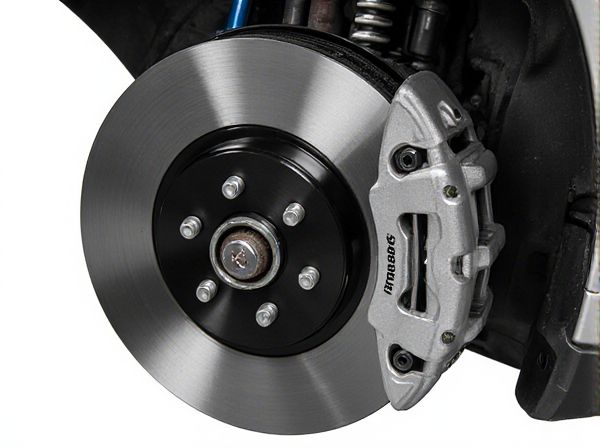
Photo illustration: Radial-Mount Calipers vs Axial-Mount Calipers
Radial-mount calipers provide superior stiffness and improved braking performance due to their design, which bolts directly through the fork leg or frame. Axial-mount calipers, while easier to install and align, may lack the rigidity of radial mounts, potentially affecting braking precision under heavy loads. Your choice depends on the balance you prefer between ease of installation and maximum braking power.
Table of Comparison
| Feature | Radial-Mount Calipers | Axial-Mount Calipers |
|---|---|---|
| Mounting Style | Bolted radially to the fork or suspension, increasing stiffness | Bolted axially through the hub or flange, traditional setup |
| Performance | Superior braking power and modulation due to reduced flex | Good performance but prone to slight flex under heavy load |
| Installation | Requires specific mounts; can be less common on stock bikes | Widely compatible and easier to install |
| Weight | Often lighter due to compact design | Typically heavier because of mounting hardware |
| Cost | Generally more expensive, premium caliper category | More affordable and commonly available |
| Best Use | High-performance racing, precision braking | Casual riding, standard braking needs |
Introduction to Brake Caliper Mounting Types
Radial-mount calipers attach directly to the fork or frame with bolts oriented perpendicular to the rotor, providing enhanced stiffness and improved braking power. Axial-mount calipers use bolts parallel to the rotor, offering simpler installation and alignment but generally less rigidity under high loads. Understanding these mounting types helps optimize brake performance and compatibility for motorcycles and bicycles.
Understanding Radial-Mount Calipers
Radial-mount calipers are designed for enhanced braking power and rigidity by directly attaching the caliper to the fork using multiple bolts, which reduces flex during intense braking. This mounting system offers improved modulation and consistent performance in high-stress riding conditions like downhill or aggressive trail riding. Compared to axial-mount calipers, radial mounts provide better alignment precision and easier maintenance, making them preferred for performance-oriented bicycles.
Overview of Axial-Mount Calipers
Axial-mount calipers are brake components fixed directly to the fork or frame via bolts aligned parallel to the axle, offering a compact and clean installation ideal for modern mountain bikes. These calipers provide consistent braking performance with simplified maintenance and reduced flex due to their rigid mounting position. Their design supports effective heat dissipation and improved tire clearance, making them a preferred choice for cross-country and trail riders.
Key Structural Differences
Radial-mount calipers feature mounting bolts positioned radially around the hub, offering superior stiffness and precise alignment that enhances braking performance under high stress. Axial-mount calipers attach parallel to the fork or frame, providing a simpler installation but less rigidity compared to radial mounts. The key structural difference lies in the bolt orientation and mounting interface, which directly impact the caliper's stability, heat dissipation, and overall braking efficiency.
Performance Implications
Radial-mount calipers provide superior stiffness and reduced flex compared to axial-mount calipers, enhancing braking precision and modulation under high-stress conditions. The radial mounting design positions the caliper more rigidly relative to the fork or frame, improving heat dissipation and consistent pad contact with the rotor during aggressive braking. Axial-mount calipers, while generally lighter and simpler to install, may allow slight flex and less direct force transfer, potentially diminishing braking efficiency in performance-focused cycling or motorcycling applications.
Installation and Maintenance Comparison
Radial-mount calipers offer a more straightforward installation process by attaching directly to the fork leg with fewer bolts, providing enhanced stiffness and improved braking performance. Axial-mount calipers require precise alignment due to their mounting on the fork's dropout or frame, making the installation slightly more complex and time-consuming. Maintenance of radial-mount calipers is generally easier thanks to their accessible mounting position, while axial-mount calipers may demand additional effort during pad changes and rotor alignment.
Applications in Modern Vehicles
Radial-mount calipers provide enhanced braking performance and stiffness, making them ideal for high-performance motorcycles and sports cars that demand precise control and consistent stopping power. Axial-mount calipers, commonly found in everyday passenger vehicles, offer cost-effective and reliable braking suited for standard commuting and moderate driving conditions. Modern vehicle applications prioritize radial-mount calipers for advanced braking systems in performance-oriented models, while axial-mount calipers remain prevalent in mass-market vehicles due to their simplicity and durability.
Cost and Availability
Radial-mount calipers generally have a higher cost due to their advanced design offering improved braking performance and stiffness, making them a preferred choice for high-end motorcycles and racing applications. Axial-mount calipers are more widely available and cost-effective, commonly found on standard motorcycles and aftermarket replacements, which makes them ideal for budget-conscious riders. Availability of radial-mount calipers can be limited to specialized suppliers, while axial versions benefit from broader distribution and greater market presence.
Pros and Cons of Each Mounting System
Radial-mount calipers offer enhanced stiffness and improved braking performance by securing directly to the fork leg, resulting in better modulation and reduced flex under heavy braking, but they can be heavier and less compatible with some frame designs. Axial-mount calipers are lighter and often easier to install or adjust due to mounting on a fixed tab, providing broad compatibility with various frames, though they may experience more flex and slightly less precise braking feel. Choosing between radial and axial mounts depends on the rider's priority for stiffness and performance versus weight savings and installation convenience.
Choosing the Right Caliper for Your Needs
Radial-mount calipers offer enhanced braking power and improved stiffness, making them ideal for high-performance motorcycles and aggressive riding styles. Axial-mount calipers provide simpler installation and better compatibility with a wider range of bikes, suited for standard or casual riders seeking reliable performance. Assess factors such as bike model, riding conditions, and maintenance preferences to select the caliper type that best aligns with your specific braking requirements.
 caratoz.com
caratoz.com